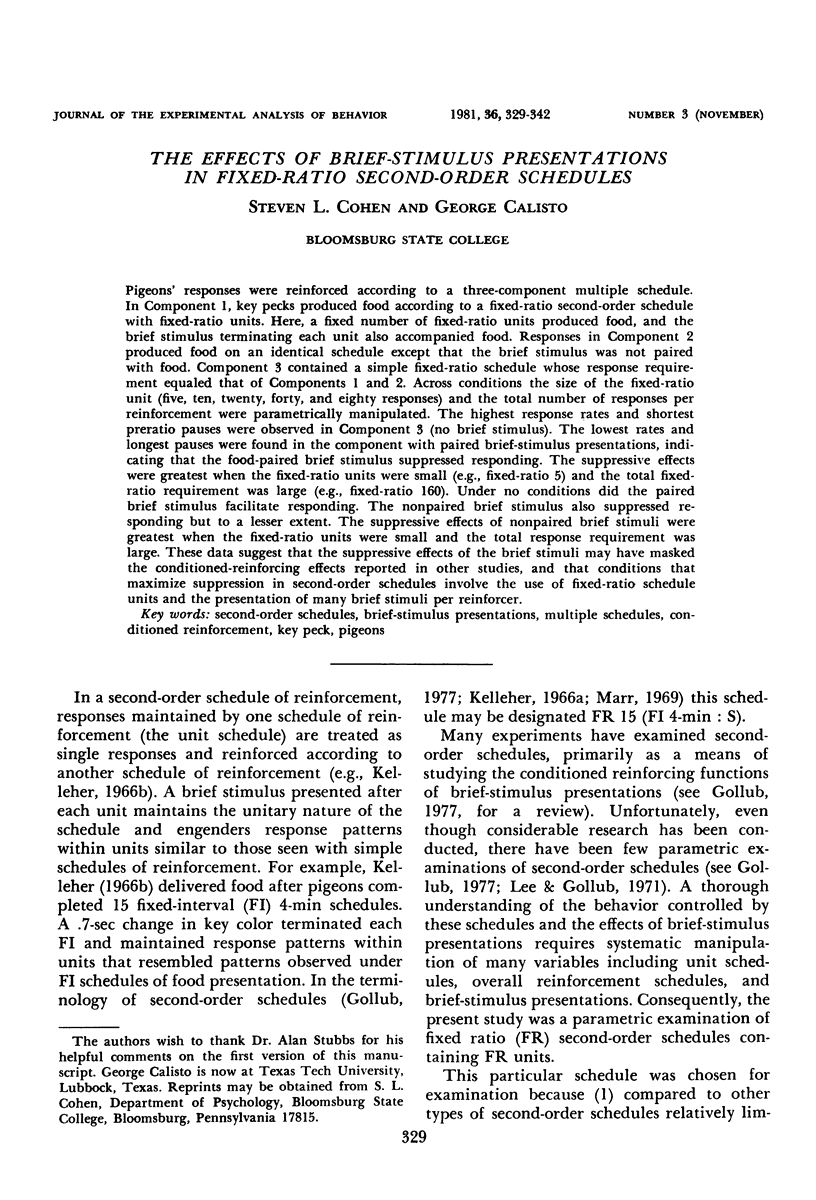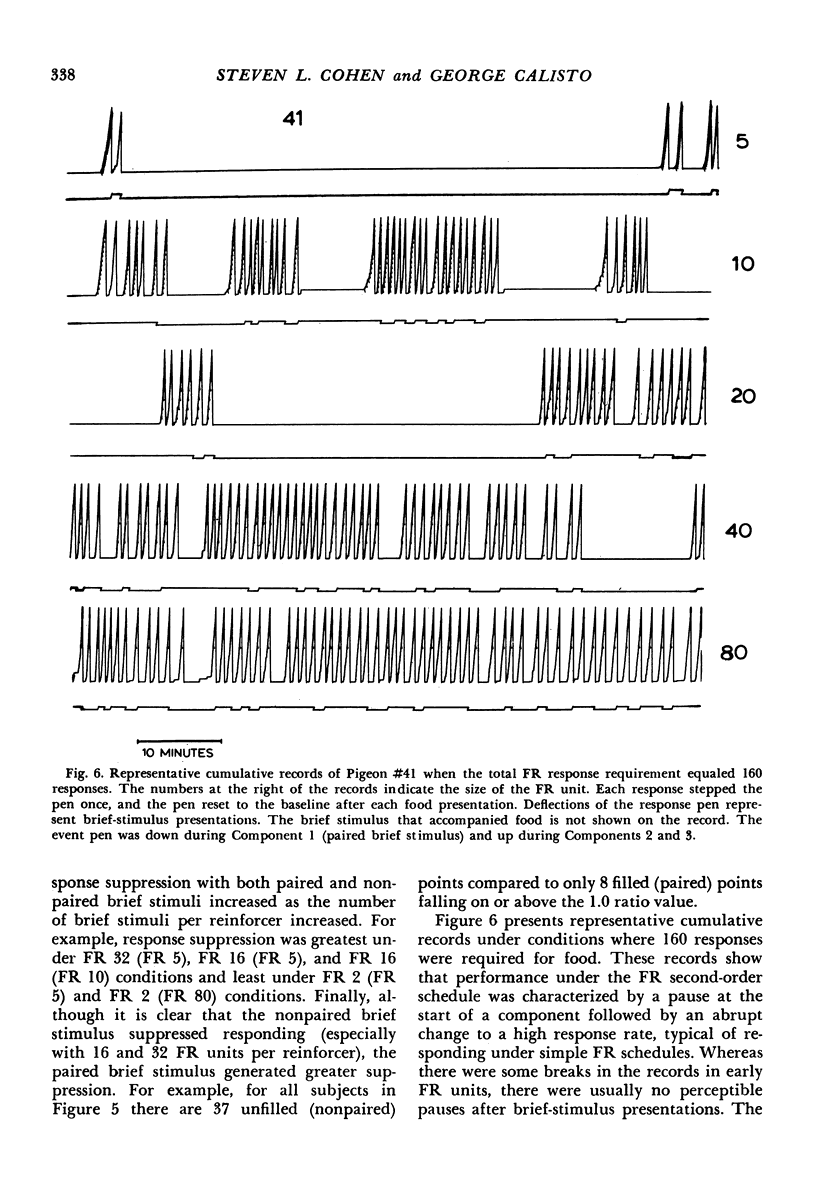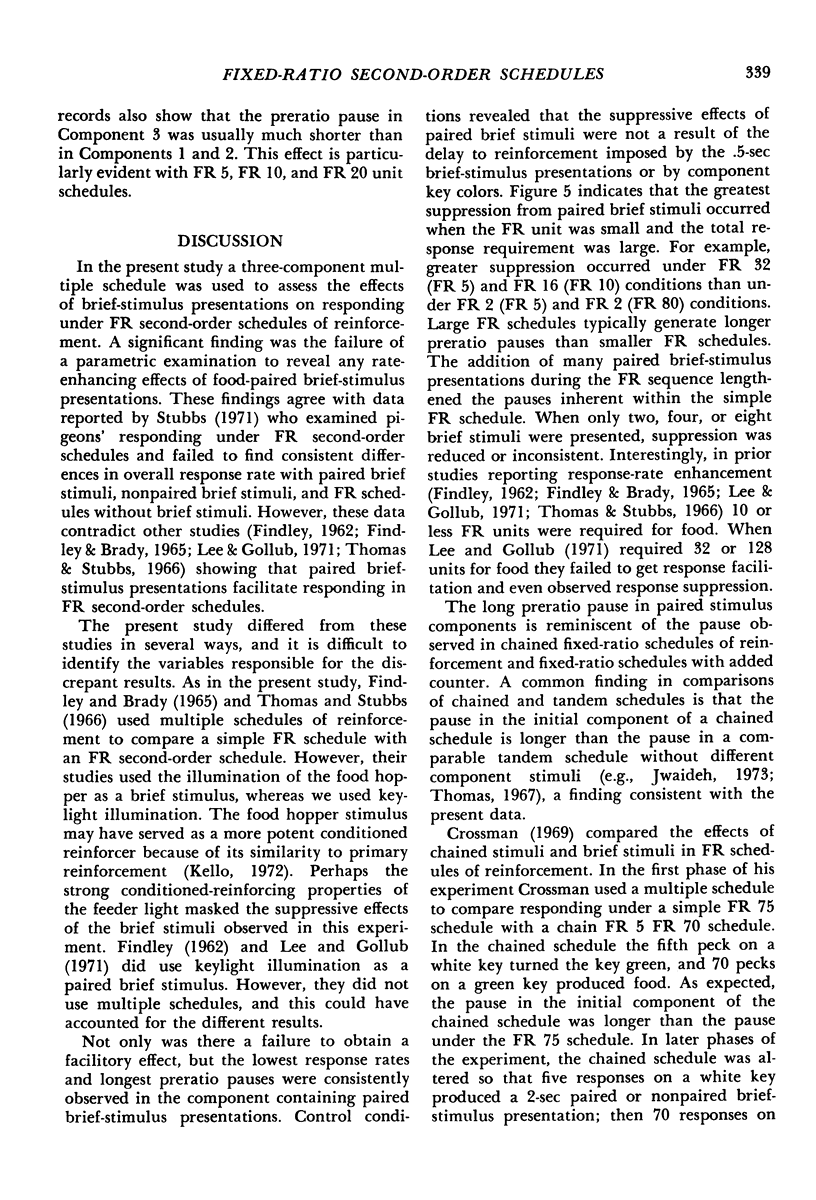Abstract
Pigeons' responses were reinforced according to a three-component multiple schedule. In Component 1, key pecks produced food according to a fixed-ratio second-order schedule with fixed-ratio units. Here, a fixed number of fixed-ratio units produced food, and the brief stimulus terminating each unit also accompanied food. Responses in Component 2 produced food on an identical schedule except that the brief stimulus was not paired with food. Component 3 contained a simple fixed-ratio schedule whose response requirement equaled that of Components 1 and 2. Across conditions the size of the fixed-ratio unit (five, ten, twenty, forty, and eighty responses) and the total number of responses per reinforcement were parametrically manipulated. The highest response rates and shortest preratio pauses were observed in Component 3 (no brief stimulus). The lowest rates and longest pauses were found in the component with paired brief-stimulus presentations, indicating that the food-paired brief stimulus suppressed responding. The suppressive effects were greatest when the fixed-ratio units were small (e.g., fixed-ratio 5) and the total fixed-ratio requirement was large (e.g., fixed-ratio 160). Under no conditions did the paired brief stimulus facilitate responding. The nonpaired brief stimulus also suppressed responding but to a lesser extent. The suppressive effects of nonpaired brief stimuli were greatest when the fixed-ratio units were small and the total response requirement was large. These data suggest that the suppressive effects of the brief stimuli may have masked the conditioned-reinforcing effects reported in other studies, and that conditions that maximize suppression in second-order schedules involve the use of fixed-ratio schedule units and the presentation of many brief stimuli per reinforcer.
Keywords: second-order schedules, brief-stimulus presentations, multiple schedules, conditioned reinforcement, key peck, pigeons
Full text
PDF













Selected References
These references are in PubMed. This may not be the complete list of references from this article.
- Cohen S. L., Calisto G., Lentz B. E. Separating the reinforcing and discriminative properties of brief-stimulus presentations in second-order schedules. J Exp Anal Behav. 1979 Sep;32(2):149–156. doi: 10.1901/jeab.1979.32-149. [DOI] [PMC free article] [PubMed] [Google Scholar]
- Cohen S. L., Stubbs D. A. Discriminative properties of briefly presented stimuli. J Exp Anal Behav. 1976 Jan;25(1):15–25. doi: 10.1901/jeab.1976.25-15. [DOI] [PMC free article] [PubMed] [Google Scholar]
- De Lorge J. The effects of brief stimuli presented under a multiple schedule of second-order schedules. J Exp Anal Behav. 1971 Jan;15(1):19–25. doi: 10.1901/jeab.1971.15-19. [DOI] [PMC free article] [PubMed] [Google Scholar]
- FINDLEY J. D. An experimental outline for building and exploring multi-operant behavior repertoires. J Exp Anal Behav. 1962 Jan;5(Suppl):113–166. doi: 10.1901/jeab.1962.5-s113. [DOI] [PMC free article] [PubMed] [Google Scholar]
- FINDLEY J. D., BRADY J. V. FACILITATION OF LARGE RATIO PERFORMANCE BY USE OF CONDITIONED REINFORCEMENT. J Exp Anal Behav. 1965 Mar;8:125–129. doi: 10.1901/jeab.1965.8-125. [DOI] [PMC free article] [PubMed] [Google Scholar]
- Ferster C. B., Peele D. B. The contribution of an added counter to a fixed-ratio schedule. J Exp Anal Behav. 1980 Jul;34(1):93–105. doi: 10.1901/jeab.1980.34-93. [DOI] [PMC free article] [PubMed] [Google Scholar]
- Jwaideh A. R. Responding under chained and tandem fixed-ratio schedules. J Exp Anal Behav. 1973 Mar;19(2):259–267. doi: 10.1901/jeab.1973.19-259. [DOI] [PMC free article] [PubMed] [Google Scholar]
- KELLEHER R. T., GOLLUB L. R. A review of positive conditioned reinforcement. J Exp Anal Behav. 1962 Oct;5:543–597. doi: 10.1901/jeab.1962.5-s543. [DOI] [PMC free article] [PubMed] [Google Scholar]
- Lee J. K., Gollub L. R. Second-order schedules with fixed-ratio components: variation of component size. J Exp Anal Behav. 1971 May;15(3):303–310. doi: 10.1901/jeab.1971.15-303. [DOI] [PMC free article] [PubMed] [Google Scholar]
- Malagodi E. F., Deweese J., Johnston J. M. Second-order schedules: a comparison of chained, brief-stimulus, and tandem procedures. J Exp Anal Behav. 1973 Nov;20(3):447–460. doi: 10.1901/jeab.1973.20-447. [DOI] [PMC free article] [PubMed] [Google Scholar]
- Rose J. E., Fantino E. Conditioned reinforcement and discrimination in second-order schedules. J Exp Anal Behav. 1978 May;29(3):393–418. doi: 10.1901/jeab.1978.29-393. [DOI] [PMC free article] [PubMed] [Google Scholar]
- Stubbs D. A., Cohen S. L. Second-order schedules: comparison of different procedures for scheduling paired and nonpaired brief stimuli. J Exp Anal Behav. 1972 Nov;18(3):403–413. doi: 10.1901/jeab.1972.18-403. [DOI] [PMC free article] [PubMed] [Google Scholar]
- Stubbs D. A. Second-order schedules and the problem of conditioned reinforcement. J Exp Anal Behav. 1971 Nov;16(3):289–313. doi: 10.1901/jeab.1971.16-289. [DOI] [PMC free article] [PubMed] [Google Scholar]
- Stubbs D. A., Vautin S. J., Reid H. M., Delehanty D. L. Discriminative functions of schedule stimuli and memory: a combination of schedule and choice procedures. J Exp Anal Behav. 1978 Mar;29(2):167–180. doi: 10.1901/jeab.1978.29-167. [DOI] [PMC free article] [PubMed] [Google Scholar]
- Thomas J. R. Chained and tandem fixed-interval schedule performance and frequency of primary reinforcement. Psychol Rep. 1967 Apr;20(2):471–480. doi: 10.2466/pr0.1967.20.2.471. [DOI] [PubMed] [Google Scholar]


